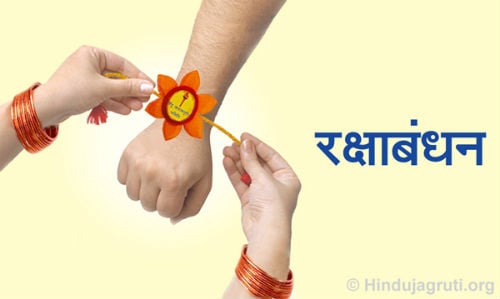
Raksha Bandhan is the festival of rakhi. This is the festival of brother and sister. This festival is celebrated on Shravan Pournima.
History of Raksha Bandhan
Deity Lakshmi tied a rakhi onto the wrist of the King Bali from hell thus making him Her brother and liberated Lord Narayan i.e. Vishnu. That day as per the Hindu lunar calendar was ‘Shravan Paurnima’.
“By tying this wristband (raksha) onto your wrist I am binding you just like the powerful and generous King Bali was bound by it. O wristband, do not get displaced.” The Bhavishya Puran states that Raksha Bandhan was basically meant for kings. A new custom of tying rakhis began from the historical ages. The sister is supposed to tie the rakhi to the brother’s wrist. The feeling behind this is that the brother should become prosperous and he should protect the sister.
Science underlying Raksha Bandhan
The science underlying Raksha Bandhan can be understood with the help of the Divine Knowledge received by Mrs. Anjali Gadgil, Sanatan’s seeker receiving Divine Knowledge.
On the day of Shravan Pournima high speed frequencies of Yama principle are activated in the universe. Particles of the Absolute Fire Element (Tej) are generated due to the friction between these high speed frequencies. These particles of Tej are emitted into the atmosphere. They become inert because of their union with the ground particles and they create a covering on the ground. This is called raksha.
Bali, the king of Hell region uses the raja-tama frequencies emitted by this raksha to nurture the negative energies. Hence, a woman ties rakhi to a man as a symbol of invoking Earth and taking Earth’s help in restraining this action of King Bali.
On the day of Shravan Pournima, Deity Laxmi tied rakhi to King Bali and freed Narayana.
Video about Science of Raksha Bandhan
Video covering practical information and science of celebrating Raksha Bandhan, its spiritual benefits, Spiritually proper Rakhi.
Significance and Purpose of Raksha Bandhan
-
The brother pledges to protect the sister in every birth. To symbolise this he allows her to tie a string on his wrist. The sister complies so that he keeps his promise. Since the historical ages this custom is prevalent to keep a brother and sister in a relationship. The rakhi is a symbol of the purity of a relationship between a sister and brother.
-
Just as the brother is bound by a promise to protect the sister after getting a string tied onto his wrist, so also the sister prays to God for his protection.
-
On this day frequencies of Lord Ganesh and deity Saraswati reach the earth in greater quantities and both the siblings benefit from the custom to a greater extent.
-
When tying the rakhi the Divine Energy principle in the woman gets manifested and is transmitted to the man through the wrist. Thus he derives 2 % benefit from it for upto 5 hours.
-
The more the spiritual emotion in the sister, the more her motivation to attain God and the more the grace of the Guru upon her the greater is the effect of her prayer unto God for her brother which results in greater spiritual progress for him.
| Spiritual level of the sister (%) | Benefit to the brother (%) |
|---|---|
| 25 – 35 | 13 |
| 35 – 45 | 16 |
| 45 – 55 | 25 |
| 55 – 70 | 50 |
| 70 – 90 | 80 |
| 90 – 100 | 100 |
(The figures in the chart are based on the sister’s spiritual level a brother benefits for upto 5 hours)
Give-and-take account between siblings
The give-and-take account between siblings is approximately 30%. This account is lessened through the medium of festivals like Rakhi Paurnima i.e. Raksha Bandhan, so though the siblings get entangled with each other at the gross level subtly the existing give-and-take account between them is settled.
The rakhi is tied every year to signify the reduction of give-and-take account between the siblings. In fact this is an opportunity for them to reduce the give-and-take account so both the embodied souls should take advantage of this opportunity.
Religious actions to be performed while tying rakhi
-
For tying the rakhi, a short wooden stool is placed for the brother to be seated
-
A rangoli design is drawn around this wooden stool
-
Sattvik frequencies are emitted from the rangoli designs made in this way and they help in making the environment of the place sattvik.
(The brother wearing new clothes and a cap on his head, applies tilak on his forehead and sits on the wooden stool. Sister stands in front of him with a platter for aukshan in her hand. Both brother and sister close their eyes, pay obeisance to the God.) -
Now both brother and sister pray to the deities for the protection of each other.
-
The sister applies tilak of vermillion to the brother.
-
The sister ties the rakhi on the right wrist of the brother.
-
After tying the rakhi, a ghee lamp arti is waved in a semi-circle in front of the brother.
-
After waving the arti, the brother gives his sister something as a gift. The sister should respect the brother by accepting his gift.
Prayer to be made while tying rakhi
येन बद्घो बली राजा दानवेन्द्रो महाबल: ।
तेन त्वामपि बध्नामि रक्षे मा चल मा चल ।।
This means, I tie you with the same raksha, by which the powerful demon king, King Bali was tied. O rakhi, you remain steadfast.
As per the teachings of Bhavishyapuran, Rakshabandhan was primarily meant for kings. Nowadays this festival is celebrated by everyone. The sister ties her brother a rakhi on the day of Rakshabandhan.
Appropriate prayer by the brother on Raksha Bandhan day : On Raksha Bandhan day every brother should pray, ‘In addition to the protection of my sister let me make efforts for the protection of society, nation and Dharma.’
Importance of tying rakhi without expectations
If the sister bears any expectation of a gift from the brother then she is deprived of spiritual benefit. When she does not have any expectations, she benefits from the blessing of the brother. Thus she benefits at a spiritual level.
How should the spiritual emotion of the sister be while tying a rakhi? Srikrushna’s finger was cut and blood was oozing out of it. He went to Draupadi. Without much thought she tore a piece of the pallu of the expensive zari saree she was wearing and tied it to His finger. On Raksha Bandhan day every sister should have the spiritual emotion like Draupadi.
Spiritual benefits of Raksha Bandhan
-
There is benefit of Sri Ganesh principle and Sri Saraswati principle. The principles of Sri Ganesh and Sri Saraswati descend on Earth in higher proportion. By praying for the protection of each other by the brother and sister, both benefit from the these deity principles.
-
There is increase in the Absolute Fire element. By waving arti the frequencies of the Absolute Fire element are emitted by the flame of the lamp and help in enhancing the Absolute Fire element in the brother.
-
The brother benefits from the Shakti principle. The Shakti principle is awakened in the woman tying rakhi. The brother benefits from this Shakti principle through the medium of the rakhi.
-
The mutual give and take between the brother and sister decreases. Generally there is 30% give and take account between a brother and sister. They complete their give and take account in the subtle form through the medium of festivals like Rakhi Pournima.
Importance of giving a sattvik gift by the brother to his sister
Non-sattvik gifts are raja-tama predominant. That is why a brother should give sattvik gift to his sister. By giving a sattvik gift like a religious holy text or chanting beads, which will augment sister’s spiritual practice, following benefits are derived:
Sattvik items do not affect the Jivas at a worldly level.
The Jiva which gives a sattvik gift benefits to the extent of 20% and the receiving Jiva benefits 18%.
By sattvik action the give and take account reduces and new account is not created.
Here the important thing is that the sister should tie the rakhi without any expectation of a gift.
How should the rakhi be?
Ancient times Rakhi
In ancient times, akshat, that is, some unbroken rice grains were covered in white cloth and it was tied with silk thread as rakhi.
Divine Knowledge received by Sanatan’s seeker Mrs. Anjali Gadgil : Akshat, that is, unbroken rice is all encompassing and silk thread has the ablility of rapidly transmitting sattvik frequencies. Thus, rakhi is made from akshat and silk thread. This rakhi is tied to the brother by the sister. The frequencies of spiritual energy in the sister are transferred to the brother when the sister ties the rakhi to him. This activates the surya-nadi (sun channel) of the brother and the Shiva principle in him is awakened. This results in disintegration of the raja-tama particles present in the atmosphere.
Asattvik Rakhi
Over the period of time, this type of rakhi has disappeared and presently, various types of rakhis are available in the market. Most of them are gaudy. They are not sattvik. The subtle effect of such rakhi is:
-
An illusory flow is attracted in the rakhi
- An illusory spiral is generated in the rakhi due to the various colourfull and flashy items used in making the rakhi.
- Illusory frequencies are spread in the body of the person upon tying such rakhi.
- Illusory particles remains active for a long time in his body.
-
Tama-predominant flow of black energy is attracted in the rakhi.
- A tama-predominant and thorny spiral is generated in the rakhi and a spiral of tama guna revolves in an activated form in the wrist of the preson to whom the rakhi is tied.
- Tama-predominant frequencies spread in the body of the person. Thereby, these tama-predominant vibrations enter every action performed by his hands.
- Particles of tama are spread in his body.
-
Tama-predominated frequencies are spread in the body of the woman tying the rakhi.
-
Tama–predominant illusory particles are spread in the environment.
Sattvik rakhi
Both the sister and brother benefit from the frequencies in a rakhi. That is precisely why one must choose a rakhi, which will preserve the God principle for longer periods instead of choosing grossly attractive ones. Otherwise the three attributes from the rakhi have an effect on the embodied souls and their attitudes too become rajasik-tamasik, etc.
A sattvik rakhi in which Divine principle will get attracted and retained should be purchased. The subtle effect given below depicts how Sanatan-made rakhi is sattvik.
-
Divine principle is attracted towards the Guru-disciple logo on the rakhi.
-
A spiral of this Divine principle is created.
-
-
A spiral is created in the rakhi in the form of nirgun principle.
-
A flow of Chaitanya is also attracted.
-
And a spiral of Chaitanya is generated in the rakhi.
-
Through this spiral, a flow of Chaitanya is emitted in the environment.
-
Particles of Chaitanya are also emitted in the environment.
-
Frequencies of Chaitanya flow from the thread of the rakhi. Therefore the brother gains Chaitanya upon tying of rakhi.
-
-
A flow of spiritual energy is attracted in the rakhi.
-
A spiral of spiritual energy is activated.
-
Particles of spiritual energy are emitted from this spiral.
-
-
A spiral of spiritual emotion (bhav) is generated in the rakhi if, while tying the rakhi the sister has the bhav that ‘I am tying the rakhi to the God residing in the brother’.
Stop denigration of deities occurring through the medium of the Rakhi
Examples of denigrating Rakhis
|
Hanuman and Cartoon Rakhis |
Rakhi symbolising friendship between India and Pakistan. |
Nowadays, rakhis are decorated with ‘Om’ or pictures of deities. After use, these rakhis are discarded and thrown away. As they are then trodden under the feet by others it actually amounts to denigration of deities. We only have to incur sin for this. Hence, immerse rakhis in flowing water. Do practice this and educate others.
Also due to commercialisation of festival and lack of proper knowledge of its spiritual significance, people go far beyond in so-called creativity that compromises festival’s very purpose. Picture above depicting ‘Rakhi symbolising friendship between India and Pakistan’ is such an example.
Reference: Sanatan Sanstha’s Holy Text ‘Holy festivals, Religious festivals and Vowed religious observances‘

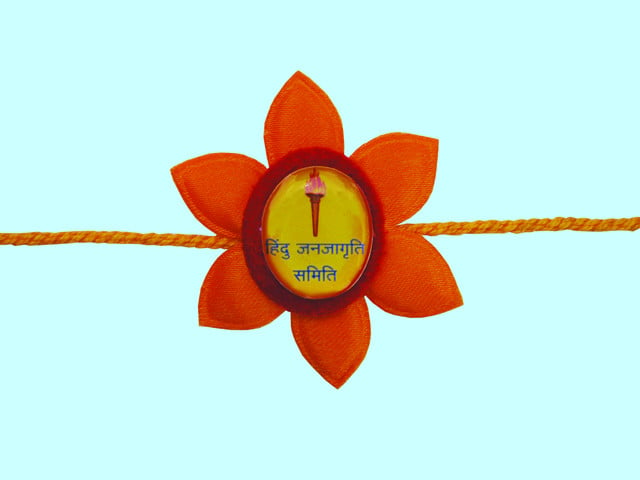
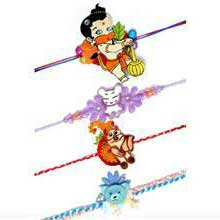
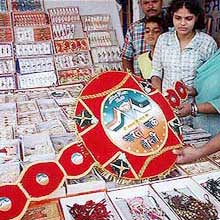
 Holi festival and Rang panchami
Holi festival and Rang panchami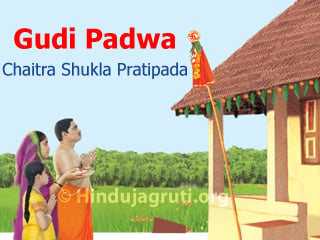 Chaitra Shukla Pratipada (Gudi Padwa)
Chaitra Shukla Pratipada (Gudi Padwa)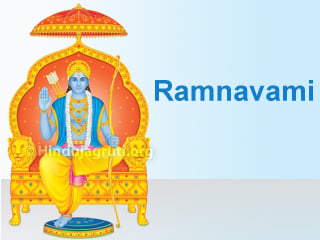 Ram Navami
Ram Navami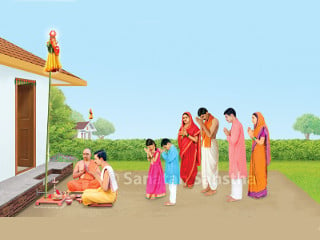 Purpose of celebrating Religious festivals and Vrats
Purpose of celebrating Religious festivals and Vrats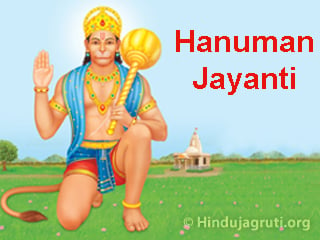 Hanuman Jayanti
Hanuman Jayanti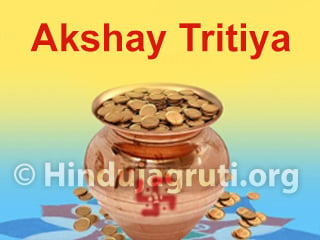 Akshay Tritiya
Akshay Tritiya